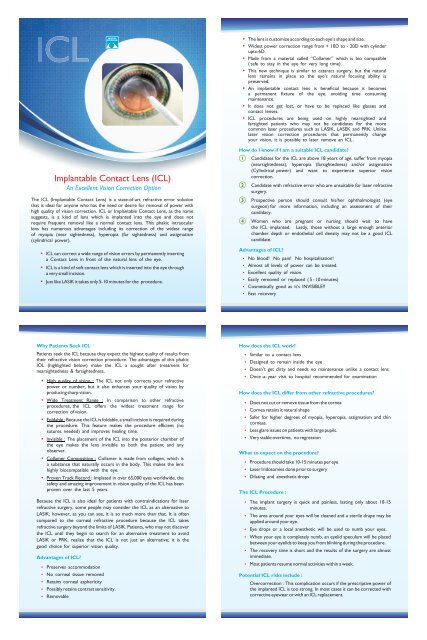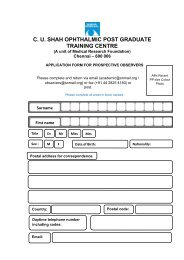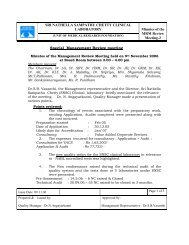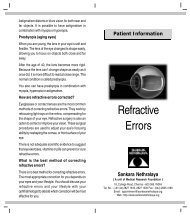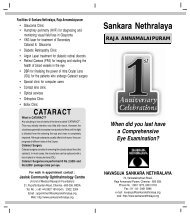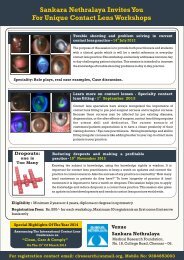Implantable Contact Lens brochure - Sankara Nethralaya
Implantable Contact Lens brochure - Sankara Nethralaya
Implantable Contact Lens brochure - Sankara Nethralaya
Create successful ePaper yourself
Turn your PDF publications into a flip-book with our unique Google optimized e-Paper software.
The lens is customize according to each eye’s shape and size.<br />
Widest power correction range from + 10D to - 20D with cylinder<br />
upto 6D.<br />
Made from a material called “Collamer” which is bio compatible<br />
( safe to stay in the eye for very long time).<br />
This new technique is similar to cataract surgery, but the natural<br />
lens remains in place so the eye’s natural focusing ability is<br />
preserved.<br />
An implantable contact lens is beneficial because it becomes<br />
a permanent fixture of the eye, avoiding time consuming<br />
maintenance.<br />
It does not get lost, or have to be replaced like glasses and<br />
contact lenses.<br />
ICL procedures are being used on highly nearsighted and<br />
farsighted patients who may not be candidates for the more<br />
common laser procedures such as LASIK, LASEK and PRK. Unlike<br />
laser vision correction procedures that permanently change<br />
your vision, it is possible to later remove an ICL .<br />
<strong>Implantable</strong> <strong>Contact</strong> <strong>Lens</strong> (ICL)<br />
An Excellent Vision Correction Option<br />
The ICL (<strong>Implantable</strong> <strong>Contact</strong> <strong>Lens</strong>) is a state-of-art refractive error solution<br />
that is ideal for anyone who has the need or desire for removal of power with<br />
high quality of vision correction. ICL or <strong>Implantable</strong> <strong>Contact</strong> <strong>Lens</strong>, as the name<br />
suggests, is a kind of lens which is implanted into the eye and does not<br />
require frequent removal like a normal contact lens. This phakic intraocular<br />
lens has numerous advantages including its correction of the widest range<br />
of myopia (near sightedness), hyperopia (far sightedness) and astigmatism<br />
(cylindrical power).<br />
ICL can correct a wide range of vision errors by permanently inserting<br />
a <strong>Contact</strong> <strong>Lens</strong> in front of the natural lens of the eye.<br />
ICL is a kind of soft contact lens which is inserted into the eye through<br />
a very small incision.<br />
Just like LASIK it takes only 5-10 minutes for the procedure.<br />
How do I know if I am a suitable ICL candidate?<br />
Candidates for the ICL are above 18 years of age, suffer from myopia<br />
(nearsightedness), hyperopia (farsightedness) and/or astigmatism<br />
(Cylindrical power) and want to experience superior vision<br />
correction.<br />
Candidate with refractive error who are unsuitable for laser refractive<br />
surgery.<br />
Prospective person should consult his/her ophthalmologist (eye<br />
surgeon) for more information, including an assessment of their<br />
candidacy.<br />
Women who are pregnant or nursing should wait to have<br />
the ICL implanted. Lastly, those without a large enough anterior<br />
chamber depth or endothelial cell density may not be a good ICL<br />
candidate.<br />
Advantages of ICL?<br />
No blood! No pain! No hospitalisation!<br />
Almost all levels of power can be treated.<br />
Excellent quality of vision.<br />
Easily removed or replaced ( 5 - 10 minutes)<br />
Cosmetically good as it’s INVISIBLE!!<br />
Fast recovery<br />
Why Patients Seek ICL<br />
Patients seek the ICL because they expect the highest quality of results from<br />
their refractive vision correction procedure. The advantages of this phakic<br />
IOL (highlighted below) make the ICL a sought after treatment for<br />
nearsightedness & farsightedness.<br />
High quality of vision : The ICL not only corrects your refractive<br />
power or number, but it also enhances your quality of vision by<br />
producing sharp vision.<br />
Wide Treatment Range : In comparison to other refractive<br />
procedures, the ICL offers the widest treatment range for<br />
correction of vision.<br />
Foldable : Because the ICL is foldable, a small incision is required during<br />
the procedure. This feature makes the procedure efficient (no<br />
sutures needed) and improves healing time.<br />
Invisible : The placement of the ICL into the posterior chamber of<br />
the eye makes the lens invisible to both the patient and any<br />
observer.<br />
Collamer Composition : Collamer is made from collagen, which is<br />
a substance that naturally occurs in the body. This makes the lens<br />
highly biocompatible with the eye.<br />
Proven Track Record : Implated in over 65,000 eyes worldwide, the<br />
safety and amazing improvement in vision quality of the ICL has been<br />
proven over the last 5 years.<br />
Because the ICL is also ideal for patients with contraindications for laser<br />
refractive surgery, some people may consider the ICL as an alternative to<br />
LASIK; however, as you can see, it is so much more than that. It is often<br />
compared to the corneal refractive procedure because the ICL takes<br />
refractive surgery beyond the limits of LASIK. Patients, who may not discover<br />
the ICL until they begin to search for an alternative treatment to avoid<br />
LASIK or PRK, realize that the ICL is not just an alternative; it is the<br />
good choice for superior vision quality.<br />
Advantages of ICL?<br />
Preserves accommodation<br />
No corneal tissue removed<br />
Retains corneal asphericity<br />
Possibly retains contrast sensitivity.<br />
Removable<br />
How does the ICL work?<br />
Similar to a contact lens<br />
Designed to remain inside the eye<br />
Doesn’t get dirty and needs no maintenance unlike a contact lens<br />
Once -a- year visit to hospital recommended for examination<br />
How does the ICL differ from other refractive procedures?<br />
Does not cut or remove tissue from the cornea<br />
Cornea retains it natural shape<br />
Safer for higher degrees of myopia, hyperopia, astigmatism and thin<br />
corneas.<br />
Less glare issues on patients with large pupils.<br />
Very stable overtime, no regression<br />
What to expect on the procedure?<br />
Procedure should take 10-15 minutes per eye<br />
Laser Iridotomies done prior to surgery<br />
Dilating and anesthetic drops<br />
The ICL Procedure :<br />
The implant surgery is quick and painless, lasting only about 10-15<br />
minutes.<br />
The area around your eyes will be cleaned and a sterile drape may be<br />
applied around your eye.<br />
Eye drops or a local anesthetic will be used to numb your eyes.<br />
When your eye is completely numb, an eyelid speculum will be placed<br />
between your eyelids to keep you from blinking during the procedure.<br />
The recovery time is short and the results of the surgery are almost<br />
immediate.<br />
Most patients resume normal activities within a week.<br />
Potential ICL risks include :<br />
Overcorrection : This complication occurs if the prescriptive power of<br />
the implanted ICL is too strong. In most cases it can be corrected with<br />
corrective eyewear or with an ICL replacement.
Undercorrection : The opposite of overcorrection, undercorrection<br />
is the result of an implantable contact lens with too weak of<br />
a prescription. Correction methods are similar to those of<br />
overcorrection.<br />
Infection : During most surgeries, there is a potential risk of an<br />
infection.<br />
Increased intraocular pressure : Pressure may build in the eye after an<br />
ICL procedure. The sooner a surgeon is alerted to this, the greater the<br />
chance of avoiding serious damage.<br />
This is detected during your follow up visits with us or in case you face<br />
acute blurring of vision or headaches, you must visit the eye clinic.<br />
ICL may rarely need to be repositioned.<br />
Damage to crystalline lens : because implantable contact lenses are<br />
implanted into the eye, there is a potential that the eye’s natural lens<br />
may be damaged during the procedure. If the damage is severe, the<br />
crystalline lens may need to be replaced with an intraocular lens.<br />
Cataract development : Over 50 percent of the population will<br />
develop cataracts by the age of 65, however, it is believed that the use<br />
of some implantable contact lenses may cause cataracts at an earlier<br />
age, this however is rare.<br />
Halos, glare, and double vision : Updated ICL models greatly diminish<br />
the risks of halos, glare, and double vision.<br />
Retinal detachment : Less than 1 percent of patients in the clinical<br />
studies were affected by retinal detachment. It should be noted,<br />
however, that the occurrence of retinal detachment increased as the<br />
degree of myopia increased.<br />
Where is the ICL placed?<br />
A trained ophthalmologist will insert the ICL through as small micro-incison,<br />
placing it inside the eye just behind the iris in front of the eye’s natural lens.<br />
The ICL is designed not to touch any internal eye structures and stay in place<br />
with no special care.<br />
What is Toric ICL?<br />
The Toric ICL is only a variant of ICL. Toric ICL corrects your<br />
nearsightedness as well as your astigmatism (cylindrical power) in one single<br />
procedure. Each lens is custom made to meet the needs of each individual eye.<br />
What is the track record of the ICL?<br />
Prior to being placed on the market, the ICL was subject to extensive research<br />
and development. Today, more than 65,000 patients worldwide enjoy the<br />
benefits of the device. In an USFDA clinical trial, over 99 percent of patients<br />
were satisfied with their implant. The ICL has a track record of stable,<br />
consistently excellent clinical outcomes. The lens has been available<br />
internationally for over 12 years.<br />
Does it hurt?<br />
No, most patients state that they are very comfortable throughout the<br />
procedure. Your ophthalmologist will use a topical anesthetic drop prior to<br />
the procedure and may choose to administer a light sedative as well.<br />
What is the ICL made of ?<br />
The ICL is made of Collamer ®, a highly biocompatible advanced lens material<br />
which contains a small amount of purified collagen. Collamer does not cause a<br />
reaction inside the eye and it contains an ultraviolet filter that provides<br />
protection to the eye. Collamer is a material proprietary to STAAR Surgical<br />
Company, the company that manufactures ICL.<br />
What if my vision changes after I receive the ICL?<br />
One advantage of the ICL is that it offers treatment flexibility. If your vision<br />
changes dramatically after receiving the implant, your doctor can remove and<br />
replace it.<br />
Patients can wear glasses or contact lenses as needed following treatment<br />
with the ICL. The implant does not treat presbyopia (difficulty with reading<br />
in people 40 and older), but you can use reading glasses as needed after<br />
receive the ICL.<br />
What type of procedure is involved in implanting the ICL?<br />
The implantation procedure for the ICL (<strong>Implantable</strong> <strong>Contact</strong> <strong>Lens</strong>) is<br />
refractive eye surgery that involves a procedure similar to the intraocular lens<br />
(IOL) implantation performed during cataract surgery. The main difference is<br />
that, unlike cataract surgery, the ICL eye surgery does not require the<br />
removal of the eye’s natural lens. The ICL procedure is a relatively short<br />
outpatient procedure that involves several important steps. The surgical<br />
procedure to implant the ICL is simple and nearly painless.<br />
As a ICL candidate, your doctor will prepare your eyes one to two weeks<br />
prior to surgery by using laser to create a small opening between the lens and<br />
the front chamber of your eye (iridotomy). This allows fluid to pass between<br />
the two areas, there by avoiding the buildup of intraocular pressure following<br />
the surgery. However, some surgeons choose to do this step on the same day<br />
of the surgery.<br />
The implantation procedure itself takes about 10-15 minutes and is<br />
performed on an outpatient basis, though you will have to make arragements<br />
for someone to drive you to and from the procedure. You can expect to<br />
experience very little discomfort during the ICL implantation. You will<br />
undergo treatment while under a light topical or local anesthetics. Following<br />
surgery, you may use prescription eye drops or oral medication.<br />
The day after surgery, you will return to your doctor for a follow-up visit. You<br />
will also have follow-up visits one month and six months following the<br />
procedure.<br />
Although the ICL requires no special maintenance, you are encouraged<br />
to visit your eye doctor annually for check-ups following the ICL<br />
procedure.<br />
Can the ICL be removed from my eye?<br />
Although the ICL is intended to remain in place permanently, a<br />
certified ophthalmologist can remove the implant in a very quick & short<br />
procedure.<br />
Is the ICL visible to others?<br />
No, the ICL is positioned behind the iris (the colored part of the eye), where it<br />
is invisible to both you and observers. Only your doctor will be able to tell that<br />
vision correction has taken place.<br />
Will be able to feel the ICL once it is in place?<br />
The ICL is designed to be completely unobtrusive after it is put in place. It<br />
stays in position by itself and does not interact with any of the eye’s<br />
structures.<br />
Where can I get my ICL procedure done?<br />
Please be aware that ICL procedure is presently available at selected centre’s<br />
& hospitals in India as it requires precision and skills. In our Institution Cornea<br />
and LASIK experts will guide you better if you are the right candidate for this<br />
procedure.<br />
<strong>Sankara</strong> <strong>Nethralaya</strong> Lasik Centre<br />
41A, A.J.C. Bose Road,<br />
Diamond Prestige Complex, Kolkata - 700 014.<br />
(N/L - Opposite of Nonapukur Tram Depot.)<br />
Ph. : (033) 65461202 / 64991200 / 65461201


